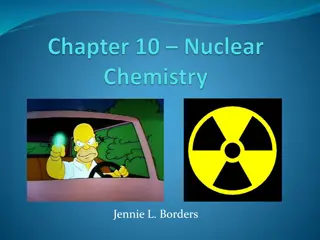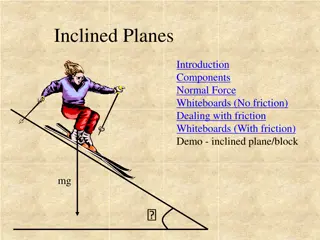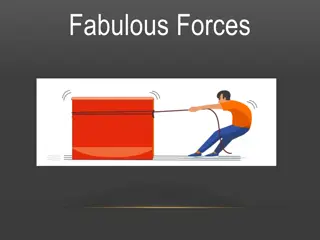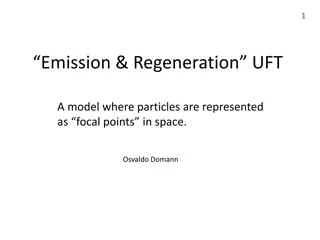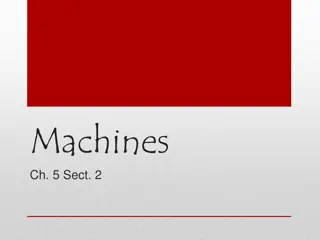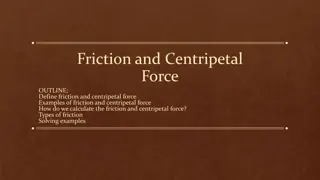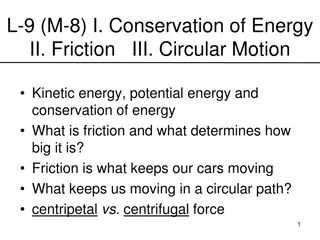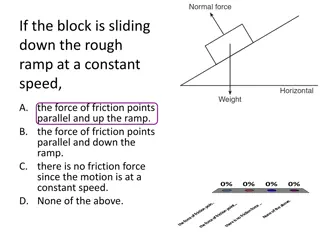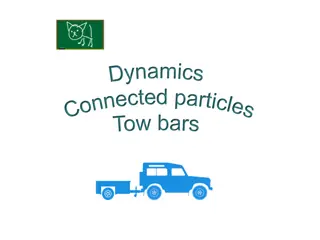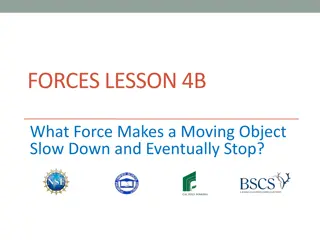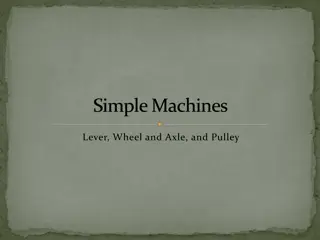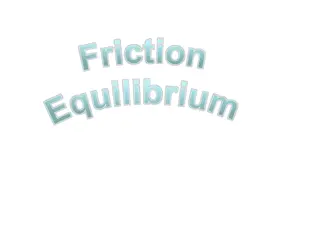
Solving Problems with Connected Particles and Friction
Explore solutions to physics problems involving connected particles with friction, pulleys, and forces. Learn about calculating accelerations, tensions in strings, and forces exerted on pulleys in various scenarios. Dive into the world of mechanics with practical examples and detailed explanations.
Download Presentation

Please find below an Image/Link to download the presentation.
The content on the website is provided AS IS for your information and personal use only. It may not be sold, licensed, or shared on other websites without obtaining consent from the author. If you encounter any issues during the download, it is possible that the publisher has removed the file from their server.
You are allowed to download the files provided on this website for personal or commercial use, subject to the condition that they are used lawfully. All files are the property of their respective owners.
The content on the website is provided AS IS for your information and personal use only. It may not be sold, licensed, or shared on other websites without obtaining consent from the author.
E N D
Presentation Transcript
Friction Connected particles
Friction: Connected particles BAT Solve problems with connected particles connected by pulleys on surfaces with friction KUS objectives Starter:
WB 1 horizontal and vertical, dynamic, forces on pulley, Two particles P and Q of masses 6 kg and 3 kg are connected by a light inextensible string. Particle P rests on a rough horizontal table. The string passes over a smooth pulley fixed at the edge of the table and Q hangs vertically. The system starts from rest. If the coefficient of friction = 1/3 , find a) The acceleration of Q b) The Tension in the string c) The force exerted on the pulley Fmax T For P Fr = ?? P 1 3 6? = 19.6 ? = pulley T For P ? = ?? Q W ? 19.6 = 6? (1) For Q ? = ?? 3? ? = 3? (2) (1) + (2) gives 29.4 19.6 = 9? ? = 1.09 Substituting to (1) or (2) gives ? = 26.1
WB 1 part (c) c) The force exerted on the pulley Resolving these forces T = 26.1 P using Pythagoras gives pulley T = 26.1 + = 2 2 26 3 . 26 3 . 37 19 . Q
WB 2 P and Q have masses of 5 kg and 10 kg respectively and are connected by a light inextensible string as shown in the diagram. The angle of the slope is where tan =3 4 The coefficient of friction between P and the rough slope is 0.2 a) Find the acceleration of the system b) Find the Tension in the string P Q sin? =3 cos? =4 5 5 3 ? 4 5 T Step 1 forces on Q using F=ma Q 10? ? = 10? (1) 10?
WB 2 B(cont) P and Q have masses of 5 kg and 10 kg respectively and are connected by a light inextensible string as shown in the diagram The angle of the slope is where tan =3 4 The coefficient of friction between P and the slope is 0.2 a) Find the acceleration of the system b) Find the Tension in the string Step 2 forces on P R= 5?cos = 4? R T P ?? = 0.2 4? = 0.8? Friction Using F=ma for P 5?sin 5?cos ? 5?sin ?? = 5? ? 3.8? = 5? (2) 10? ? = 10? (1) 6.2? = 15? 1 + (2) Solving gives ? = 4.05 ?? 2and ? = 57 ?
WB 3 blocks A and B have masses of 2 kg and 5 kg respectively and are connected by a light inextensible string as shown in the diagram. The coefficient of friction between P and the rough slope is 0.2 The system is released from rest. By modelling A and B as particles and ignoring air resistance a) Find the acceleration of block B b) Find the Tension in the string c) State how you have used that the string is inextensible in your calculations T B Step 1 forces on B using F=ma A B 5? 30 5? ? = 5? (1)
WB 3(cont) blocks A and B have masses of 2 kg and 5 kg respectively and are connected by a light inextensible string as shown in the diagram. The coefficient of friction between P and the rough slope is 0.2 The system is released from rest. By modelling A and B as particles and ignoring air resistance a) Show that the acceleration of block B is 280 7 3 10 ? b) Find the Tension in the string c) State how you have used that the string is inextensible in your calculations 3 R= 2?cos30 = 2? R T 3 3 A ?? = 0.2 2? = 10? Friction 30 Using F=ma for A 2?sin30 2?cos30 ? 2?sin30 ?? = 2? 3 ? ? 10? = 5? (2) Step 2 forces on A 5? ? = 5? (1) 3 5? ? 10? = 7? 1 + (2) Solving gives ? = 5.36 ?? 2and ? = 22.2 ?
WB 4 slope and vertical, dynamic, up slope, suvat, A particle P of mass 5 kg lies on a roughinclined plane of angle = 35 . Particle P is connected to a particle Q of mass 6 kg by a light inextensible string which lies along a line of greatest slope on the plane and passes over a smooth peg. The system is held at rest with Q hanging vertically 2 m above a horizontal plane. The system is now released from rest. If the coefficient of friction = 1/3 and assuming P does not reach the peg, find, to 3sf: a) The acceleration of Q b) How long t takes for Q to hit the horizontal plane c) the total distance that P moves up the plane For Q ? = ?? 6? ? = 6? pulley R (1) T T P For P ? = 5???? 35 Q WQ WP For P Fr = ?? 1 3 5?cos35 = 13.379 ?? ??? ?? ?? ??? ?? ? = For P ? = ?? ? 5?sin35 13.379 = 5? (2) (1) + (2) 6? 5???? 35 13.379 = 11? Gives ? = 1.57 ?? 2
WB 4 (cont) slope and vertical, dynamic, suvat b) How long t takes for Q to hit the horizontal plane pulley R T T = + 2 ? = 2 ? = 0 ? ? = 1.57 ? s ut 1at P 2 Q Gives 2 = 0 +1 2(1.57) ?2 WQ 2m WP ? = 2.55 ???? ?? ??? ?? ?? ??? ?? Second, find acceleration given that there is no longer any pull from Q (Tension) c) the total distance that P moves up the plane. First, find v after 2.55 seconds = + v u at For P ? = ?? Gives v = 0 + 1.57 2.55 = 4 ?? 1 5?sin35 13.379 = 5? ? = 8.30
WBxg slope and vertical, dynamic, suvat (cont more) Second, find acceleration given that there is no longer any pull from Q (Tension) pulley R T T For P ? = ?? P Q 5?sin35 13.379 = 5? WQ 2m WP ? = 8.30 ?? ??? ?? ?? ??? ?? Third, distance P travels until it stops = + 2 2 2 v u as 02= 42+ 2 8.30 ? ? = 0.964 ? So total distance P moves up the plane = 2.96 m.
self-assess One thing learned is One thing to improve is
WBxf slope and vertical, dynamic, decide direction A particle A of mass 4 kg lies on an inclined face of a rough wedge. This face is inclined at 30 to the horizontal. The wedge is fixed on horizontal ground. Particle A is connected to a particle B, of mass 3 kg, by a light inextensible string. The string passes over a small light smooth pulley which is fixed at the top of the plane. The section of the string from A to the pulley lies in a line of greatest slope of the wedge. The particle B hangs freely below the pulley, as shown in the diagram. The system is released from rest with the string taut. Given that the coefficient of friction of the wedge surface is 0.3 find a) the tension in the string c) the magnitude of the resultant force exerted by the string on the pulley. T A (4 kg) T B (3 kg) 4 g 3 g 30 d) The string in this question is described as being light . (i) Write down what you understand by this description. (ii) State how you have used the fact that the string is light in your answer to part (a).

